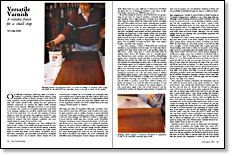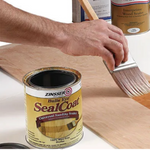All About Varnishes

Varnish is a term used to describe any film-forming reactive finish made from combining a vegetable oil (which cures by polymerization) with one or more modifying resins, dissolved in a petrochemical-based solvent to facilitate its application.
The Basics:
• Common ingredients: Most products use a mix of standard oils and resins
• Proprietary formulas: Products differ based on a manufacturer’s recipe
• Varying dry times: The percentage of oil affects dry time
Common ingredients
Typically, linseed, soybean, and tung oil are the most widely used oils, and alkyd (polyester), phenolic, and polyurethane are the most commonly used resins. No matter what the specific chemical makeup, all oil-based varnishes cure to a tough and somewhat elastic film as they dry, which is one reason they are so prized by woodworkers. Because they take longer to dry than shellac and lacquer, oil-based varnishes are used more by hobbyists and one-person professional shops than by large production shops; and more often than not, the varnish is applied by brush, though it can also be wiped or sprayed onto the surface.
Proprietary formulas
When shopping for varnish, you can choose from any number of familiar brand names — Behlen, Benjamin Moore, McCloskey, Minwax, Watco, Waterlox, Zinsser — and their chemical formulations vary significantly. Manufacturers are not required by law to list all of the precise proportions and ingredients that go into the mix (such information is considered proprietary) so it’s impossible to make accurate comparisons between one varnish and another by reading the labels.
Varying dry times
In the language used by the coatings industry, varnishes are categorized by their oil length, which is a term used to describe the ratio of oil to the modifying resins used in the mixture. The amount of oil used greatly affects the plasticity of the cured finish, as well as how long it takes to dry. Mixtures containing 75% or more of oil are called very long-oil varnishes. They take longer to dry, the cured finish remains more flexible over time (though it offers less in the way of abrasion resistance), and they are often applied with a wiping rag.
Long-oil varnishes contain 60% to 75% oil, and they comprise what are often called “quick-dry” varnishes, when they are mixed with fast-drying solvents.
Medium-oil varnishes contain 45% to 60% oil, and most of the brushable varnish finishes available on the market fit into this category. They take longer to dry, but the cured result is a surface film that is more abrasion, chemical, and water resistant than the longer oil varieties.
Short-oil varnishes contain less than 45% oil, and they’re used for finishing metal, not wood.
Fine Woodworking Recommended Products


Osmo Polyx-Oil

Diablo ‘SandNet’ Sanding Discs























Log in or create an account to post a comment.
Sign up Log in